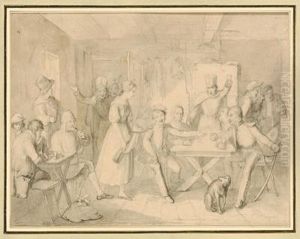Carl Engel Von Der Rabenau Paintings
Carl Engel von der Rabenau was a German painter and illustrator born on June 16, 1864, in Frankfurt am Main, Germany. Coming from a family of artists, von der Rabenau was immersed in the arts from an early age. His father, Johann Jakob Engel, was also a painter, which gave Carl a foundation in the arts and probably influenced his decision to pursue a career in the same field.
Von der Rabenau studied at the Städelsches Kunstinstitut in Frankfurt under the tutelage of Jakob Fürchtegott Dielmann and Eduard von Steinle, who were significant figures in the German art scene of the time. His education was traditional, and he benefited from the rich cultural environment of Frankfurt, which was an important center for the arts in Germany during the late 19th century.
After completing his studies, von der Rabenau traveled extensively throughout Europe, which was a common practice among artists of his generation. These travels allowed him to absorb various artistic influences, particularly the styles and techniques of the Old Masters, which would later inform his own work.
Von der Rabenau’s oeuvre was largely composed of landscapes, genre scenes, and portraits. His landscapes often depicted the German countryside and were praised for their detailed realism and atmospheric qualities. Von der Rabenau was part of a tradition of landscape painting that sought to capture the spirit and essence of nature, and his works are characterized by a meticulous attention to detail and a serene, almost idyllic quality.
By the early 20th century, Carl Engel von der Rabenau had established himself as a respected artist in Germany. He participated in numerous exhibitions and his works were collected by art connoisseurs and institutions. Despite the changing artistic trends of the time, including the rise of modernism and expressionism, von der Rabenau remained committed to his more traditional, realist style.
Von der Rabenau continued to paint and exhibit his work up until his death on March 23, 1931, in Frankfurt am Main. Today, his paintings can be found in various art collections in Germany and beyond, and they continue to be appreciated for their beauty and craftsmanship. While he may not be as well-known as some of his contemporaries, Carl Engel von der Rabenau's contributions to German art during the late 19th and early 20th centuries remain significant.



